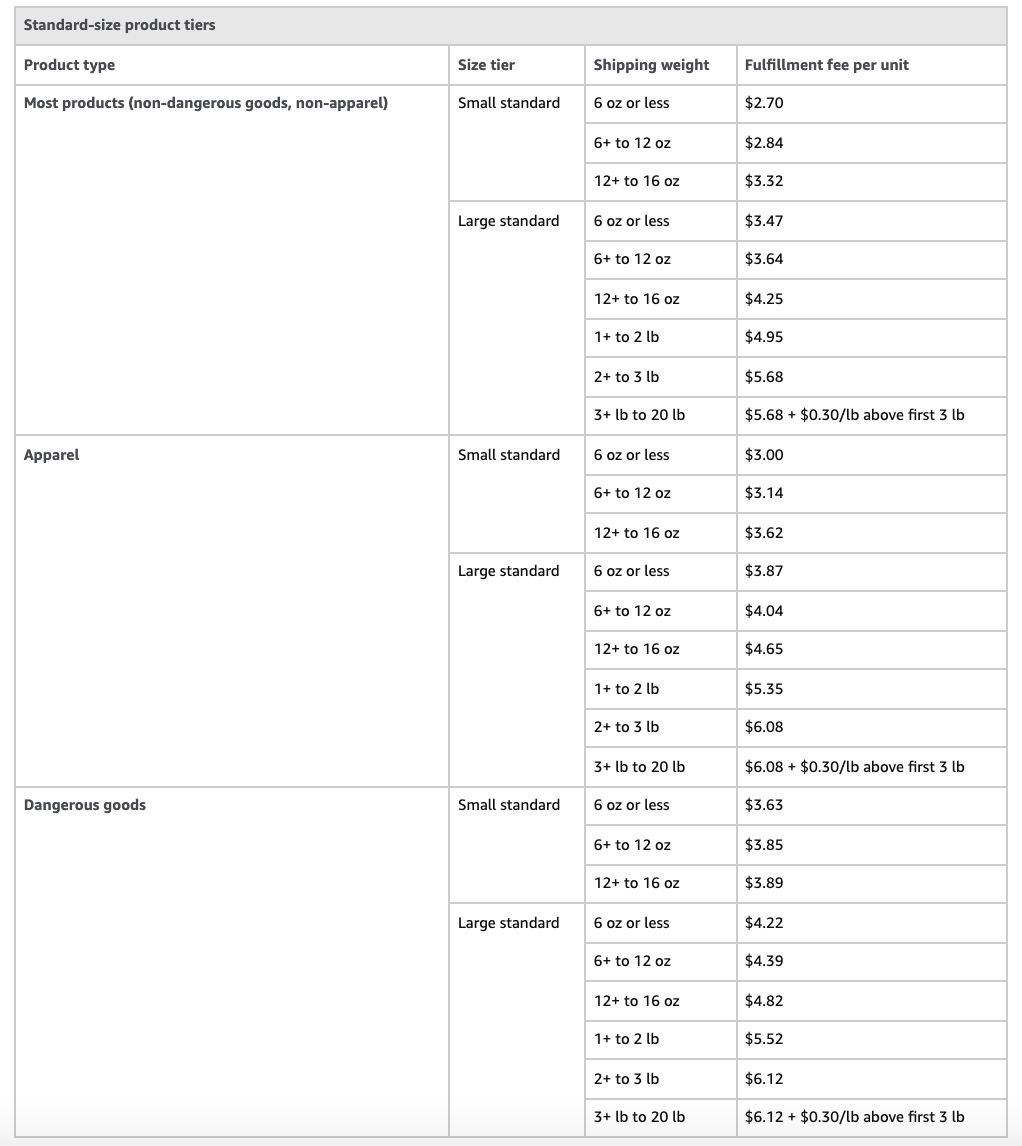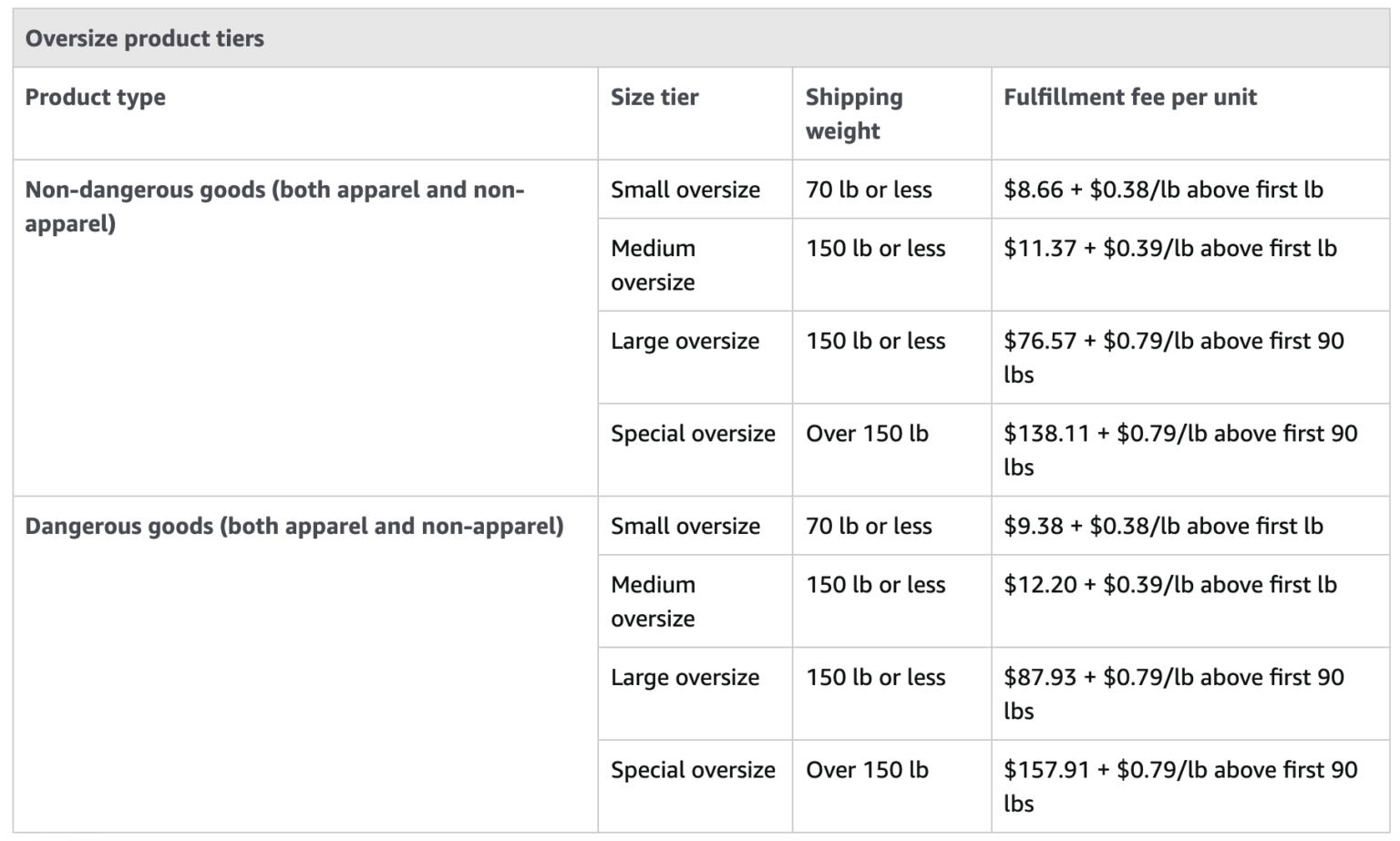Popular Posts
- Order Management
- TikTok Shop
- Temu
- About 4Seller
- Amazon
- Shopify
- Inventory Management
- Amazon MCF&FBA
- Amazon Shipping
- UPS
- FedEx
- DHL Express
- Listing Management
- Seller Tips
- Creator Bulk Invite
- eBay
- GLS
- Marketplace News
- Shein
- Amazon MCF
- Royal Mail
- Walmart
- Multi-channel Store
- Shipping Integration
- Logistics Rule
- Stripe Tracking Sync
- Poste Italiane
- UniUni
- USPS
- PayPal Tracking Sync
- OTTO
- Walmart WFS
- Yodel
- Kaufland
- BRT
- CaiNiao
- Chronopost
- CIRRO
- Correos
- Correos Express
- Deutsche Post
- DHL Parcel
- Etsy
- Evri
- GOFO
- Inventory Sync
- Beginner Tutorial
- DPD
- Shipping Label
- DHL
- FBM
- Platform Integration
- AliExpress
- 3PL
- Cdiscount
- OMS
- WooCommerce
About Amazon FBA Fees: Everything You Need to Know
 By Amelia10 Apr,2024
By Amelia10 Apr,2024
Amazon’s FBA Fees Affected by The Size and Weight of Product
Fulfillment by Amazon (FBA) Charges Higher Fees for Items Sold Through External Channels
Consideration of Additional Amazon FBA Fees
Referral Fees
Removal Order Fees
Returns Processing Fees
Unplanned Service Fees
Enroll in FBA Small and Light Program to Reduce Costs
Free Tools and Calculators of FBA
Fulfillment by Amazon: Is it right for your business?
Fulfillment by Amazon (FBA) brings many conveniences to e-commerce retailers. They can store their products in Amazon's warehouses, and Amazon can be responsible for packaging and shipping regardless of whether these products are sold on the Amazon platform.
In addition to providing fast and efficient fulfillment services, FBA also provides retailers with excellent customer service and gives them some marketing advantages, such as eligibility for Super Saver Shipping and Amazon Prime. These advantages make Amazon Logistics an important force in helping small businesses increase sales. Kiri Masters, founder of Bobsled Marketing, pointed out that FBA can help online retailers increase sales by 30-50%.
Although following the FBA trend is extremely attractive, we must also be soberly aware that FBA involves a range of fees, including some obvious and some not-so-obvious fees, which users need to weigh carefully before deciding to use FBA.
Amazon’s FBA Fees Affected by The Size and Weight of Product
Specifically, the size and weight of the product and the sales channel determine FBA’s fee structure. The fees Amazon charges sellers are mainly divided into two categories:
1. Fulfillment fee: Which covers the cost of packaging, transportation and customer service provided by Amazon;
2. Monthly inventory storage fee: Which is used to compensate for the cost of storing goods in Amazon warehouses (i.e., fulfillment centers). Amazon divides products into standard and extra-large sizes based on their size and weight. Standard size products should be no larger than 15" x 12" x 0.75", while oversized products should be larger than 18" x 14" x 8".
Source
Whether a product meets the standards of standard size or oversized size will directly affect its fulfillment and warehousing charges. For example, the fulfillment fee for standard-size products weighing 6 ounces or less is $2.70.
Source
Amazon’s FBA fees apply to standard size products for domestic and international orders. Oversized products, on the other hand, have a different set of tiers that determine their fulfillment charges.
Source
The table below details fulfillment charges for different sizes and weights of products. We can see that fulfillment fees are relatively low for small, lightweight items like T-shirts, but as the size and/or weight of the product increases, the fulfillment fees increase accordingly.
Source
In addition, whether a product is standard or oversized will also affect its warehousing charges. For example, during the holidays from October to December, FBA’s warehousing fees will be relatively high.
Source
Amazon’s storage fee system is relatively complex, especially for specific types of products. For example, warehousing costs for goods that are considered "dangerous goods" will be significantly higher than for ordinary goods. In addition, for those products stored in Amazon fulfillment centers for more than one year, there will be an additional long-term storage fee in addition to the regular monthly storage fee.
If you'd like to learn more about Amazon's product size and storage regulations, please visit the related guidelines page.Fulfillment by Amazon (FBA) Charges Higher Fees for Items Sold Through External Channels
It is worth noting that for products sold outside the Amazon platform, the cost of using Fulfillment by Amazon (FBA) services will be relatively high. Although Amazon's market share in the e-commerce field is close to 50%, about 80% of Amazon merchants still choose to sell products through multiple channels. This multi-channel sales model is called multi-channel fulfillment (MCF). In this scenario, sellers need to ship the product to an Amazon fulfillment center and pay corresponding storage fees based on the product's size and storage time. When a customer places an order, whether through the seller's own website or another third-party platform, Amazon is responsible for receiving the order, packaging it, and shipping it directly to thecustomer.
MCF fees will vary based on the product's shipping needs. Amazon offers different MCF fees for standard, expedited, and priority shipping. At the same time, the size of the product is also one of the key factors that affects the cost. There will be different costs for standard and oversized products.
For example, for a standard-size T-shirt that weighs 5 ounces after packaging, if you choose standard shipping, the MCF fee will be $5.95.
SourceConsideration of Additional Amazon FBA Fees
In addition, sellers need to consider some other additional costs when using Amazon FBA services. While these fees aren't something every seller will encounter, they still need to be considered when setting your budget.
Among them, Selling fees are a part that cannot be ignored. If you sell on Amazon through the Personal Selling Plan, you will pay a $0.99 sales fee for each item sold. If you choose the professional sales plan, you need to pay a fixed fee of US$39.99 per month, and the per-piece fee is waived.
SourceReferral Fees
Referral fee is another fee that sellers must pay when selling items on Amazon, and the amount depends on the category the item falls into. For example, the referral rate for books is 15% plus a $1.80 closing fee, while the referral rate for mobile phones is 8%.
Source
Removal Order Fees
In addition, if you need to remove items from Amazon’s warehouses, you will also need to pay a relocation order fee, which is based on the size and weight of the item.
Source
For more detailed guidance on removal order fees, sellers can review the relevant guide.
Returns Processing Fees
Return processing fees are fees incurred by Amazon for free return shipping on certain categories of items. This service is mainly applicable to clothing, jewelry, footwear, handbags, luggage and other products, aiming to enhance consumer trust and promote purchase intention. Amazon bears the return shipping costs for these items, but will charge the seller a corresponding return processing fee.
Source
Specifically, the return processing fee is a fee that Amazon charges customers for returning products that fall into product categories for which Amazon offers free return shipping.
Unplanned Service Fees
In addition, if items are not labeled and barcoded according to Amazon's specific specifications, or if inventory is improperly prepared, Amazon will charge an unplanned service fee to address these issues. Sellers should ensure items are properly prepared and labeled to avoid incurring additional charges.
Enroll in FBA Small and Light Program to Reduce Costs
For new products that meet specific size and weight requirements, Amazon offers the Small and Light program to help sellers reduce fulfillment costs. Products that qualify for the program can enjoy lower FBA fees. However, certain types of products, such as food, alcohol, and certain electronics, are not eligible for this program.
SourceFree Tools and Calculators of FBA
To make calculating FBA fees more convenient, Amazon provides a variety of free tools and calculators. For example, the FBA Revenue Calculator helps sellers estimate their fulfillment costs, including item prices and shipping costs, allowing for real-time cost comparisons. In addition, the cost estimator tool can also provide sellers with cost estimates for inventory items, helping sellers better understand expected costs.
SourceFulfillment by Amazon: Is it right for your business?
While there are multiple fees involved with using Fulfillment by Amazon, it also comes with benefits such as fast fulfillment, reduced burden on individual business operations, marketing advantages, and reduced costs for specific products. However, every business and product is unique, so it’s crucial to accurately assess the expected costs before deciding to use FBA services.
Topics
All Topics
- Order Management
- TikTok Shop
- Temu
- About 4Seller
- Amazon
- Shopify
- Inventory Management
- Amazon MCF&FBA
- Amazon Shipping
- UPS
- FedEx
- DHL Express
- Listing Management
- Seller Tips
- Creator Bulk Invite
- eBay
- GLS
- Marketplace News
- Shein
- Amazon MCF
- Royal Mail
- Walmart
- Multi-channel Store
- Shipping Integration
- Logistics Rule
- Stripe Tracking Sync
- Poste Italiane
- UniUni
- USPS
- PayPal Tracking Sync
- OTTO
- Walmart WFS
- Yodel
- Kaufland
- BRT
- CaiNiao
- Chronopost
- CIRRO
- Correos
- Correos Express
- Deutsche Post
- DHL Parcel
- Etsy
- Evri
- GOFO
- Inventory Sync
- Beginner Tutorial
- DPD
- Shipping Label
- DHL
- FBM
- Platform Integration
- AliExpress
- 3PL
- Cdiscount
- OMS
- WooCommerce
Popular Posts
- 17 Dec,2024
Table of Content
Popular Posts
- 17 Dec,2024
Back to top














